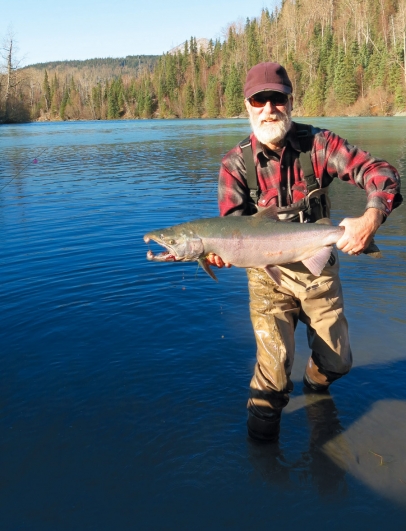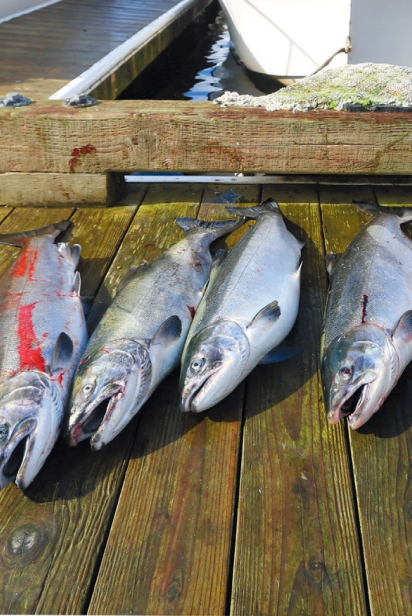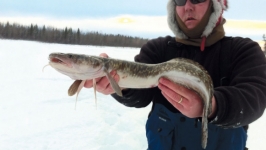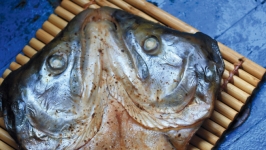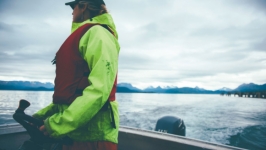Off the Hook
Caring For Your Catch
In many traditional cultures, wealth is not measured in banknotes or gold, but rather in more tangible assets, such as the bounty of the land and sea. Even today in many Alaskan villages, a full freezer has greater value than a bank account or portfolio of stocks. This is a virtue many of us hunters, gardeners, gatherers, (and yes, fishermen) can appreciate. There is something profoundly basic — shared across generations and cultures and deeply embedded in our psyches and DNA — that compels us to put away our own stores, and to do so with our own hands.
Here in Alaska, amidst one of the few remaining strongholds of wild salmon, harvesting the riches of the sea is an annual ritual. Anglers from across the state and visiting from around the globe descend upon our streams and rivers, leaving with not only a wealth of experiences, but also with a treasure trove of some of the freshest, most delectable food available.
This is where we might also take a lesson from native cultures and honor the fish that has given its life for us. Today, that means taking proper care of our fish and not letting it go to waste, taking only what we need, and processing it properly so that come springtime it is in nearly as good condition and tastes almost as delicious as the day it was caught. It’s not difficult. The secret to good quality all starts when the fish is first hooked.
It might not seem so when an enraged sockeye is furiously ripping line off the reel, but fish is an extremely delicate food and needs to be handled very gently. That means not allowing it to flop around on shore and keeping its struggle to a minimum.
It’s best to dispatch the fish right away with a sharp whack to the skull. At one time, it was common practice to keep fish alive on a stringer. The thinking was that the fish would remain fresher the longer it lived. This, however, is a complete fallacy. Fish, like any other animal, build up lactic acid with an increase in stress, which makes flesh tough. It’s the same reason hunters want a quick, clean kill.
Once the fish is immobilized, it should never be picked up by the tail, as this will break the vertebrae, which will in turn cause what is commonly referred to as the “bloodline,” the jellylike substance that runs along the backbone, to leach into the meat. This bloodline serves as a kidney function and the enzymes it contains will immediately begin to affect a fish’s delicate flesh and flavor.
The next step in taking care of your catch is to immediately bleed the fish. This is best accomplished by cutting the gill arches, which should be done right away while the heart is still pumping.
Then it’s on to the ice, perhaps the most important and most often overlooked step in maintaining a quality product. Icing the fish as soon as possible will keep your catch firm and fresh. The colder the better. On extended trips, try using frozen milk jugs, so as not to end up with slush, which can cause fish to turn soft. Another option is to build a rack on the bottom of the cooler, allowing a place for the water to drain. If you have hired a charter, always check with your skipper and make sure they plan on bleeding and icing your catch.
If keeping the fish whole, which occasionally I do with lake-caught trout or kokanee, I will remove the viscera, or guts, and the gills right away. Both of these areas contain enzymes that can have a negative impact on the meat. In most cases, however, with large fish such as salmon, we are filleting. When keeping salmon, always start with the brightest, firmest fish possible. It’s common to hear fishermen refer to blush salmon as “smokers,” but smoking a subpar fish does absolutely nothing to improve its quality. I am a firm believer in the adage: “Junk in the smoker, junk out of the smoker.”
When filleting, start with a level and clean surface. That means really looking over a boat launch cleaning station. Whether at one of our local harbors or at river cleaning tables, take a close look at the accumulation of slime and guts, and the flies that accompany it. It does not take long, especially on a warm day, for the filth and bacteria to build up. That’s why it’s a good idea, if using a public cleaning station, to tote along a spray bottle with bleach solution and a scouring pad.
If freezing for extended periods, nothing beats vacuum packing. Wrapping fish in plastic wrap before placing it in the vacuum bag will create better suction and ensure a better seal. Once the fish is sealed and ready, spread the packages out on the freezer shelf, and only freeze a few packages at a time. Leave the rest in the refrigerator until those in the freezer are frozen solid. This allows the fish to freeze faster, a key to avoiding, or at least putting off, freezer burn. Remember, the quicker a fish is frozen, the better. It’s recommended that fish be frozen in two hours or less. And always label what it is and when it was frozen. Once the packages are frozen solid, I stack them in the freezer, but am careful to place a section of newspaper between each package. This will prevent them from sticking together and possibly being punctured.
These few simple practices will assure quality and allow us to better honor the fish we catch. Good luck fishing and good eating!


